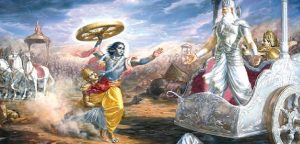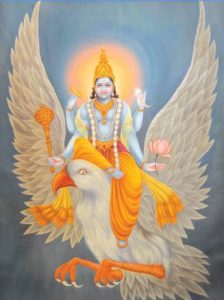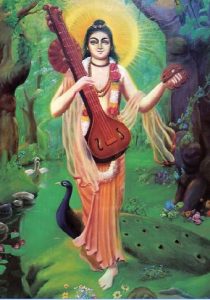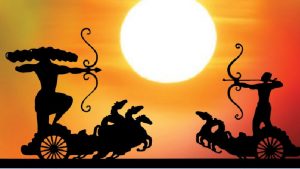 The Puranas provide solutions to the major riddles of mundane life by describing how the world was created and who created it. The Puranas contain myths and genealogies, written in a flowing form like an epic poem, to explain the history and importance of religious rituals, duties, and developments. Out of the two chief segments, first ones are the Myths, which are in the form of traditional stories about past events, usually involving gods and goddesses. The second components, which coincide with the Myths, are the genealogies, or the pedigree of ancestors and descendants. The Puranas reveal stories of creation of the world, legends of the Gods, and expounding ways to perform religious rituals.
The Puranas provide solutions to the major riddles of mundane life by describing how the world was created and who created it. The Puranas contain myths and genealogies, written in a flowing form like an epic poem, to explain the history and importance of religious rituals, duties, and developments. Out of the two chief segments, first ones are the Myths, which are in the form of traditional stories about past events, usually involving gods and goddesses. The second components, which coincide with the Myths, are the genealogies, or the pedigree of ancestors and descendants. The Puranas reveal stories of creation of the world, legends of the Gods, and expounding ways to perform religious rituals.
Five distinctive signs or streaks inhere in all the major Puranas, which are their points of convergent philosophies. First, there is a depiction of the creation of the universe. Numerous traditional stories of how the world was created, who created it, and why it was created, are narrated in each of them. In Hindu tradition, it is believed that the forces of evil often caused chaos and destruction, so the second sign is the repeated creation of the universe after it has been destroyed.
The most well-known sign is the third one, which relates to the the tales of gods and goddess and their genealogies, like who their parents and children are. The fourth sign deals with the primal humans and their earthly reigns. The fifth and final sign of the Puranas is the description of famed solar and lunar dynasties. Essentially, two primal beings claimed descent one from the sun and other from the moon, and this explains the origin of those dynasties.
Puranas are a part of Smriti, that is, the non Vedic Scriptures. The treatise titled the Hindu World has dated Puranas appearance as between the 6th Century A.D. to 16th Century A.D. It is commonly believed that the Puranas are the Vedas of the common folk. There are 18 major Puranas, or popularly called Mahapuranas, six out of which relate to Lord Vishnu, six are devoted to Lord Shiva and six ascribe to Lord Brahma. These Mahapuranas have been described in brief in the Hindu World in the following manner:
 THE SIX VISHNU PURANAS are revered as sattvic in nature:
THE SIX VISHNU PURANAS are revered as sattvic in nature:
(I) Vishnu Purana, consists of 7,000 stanzas and bears all the attributes of the true Purana. Legend has it that it was first revealed by Lord Brahma to Sage Ribhu, who in turn revealed it to Sage Pulastya. Sage Pulastya thereafter passed it on to Sage Parasara, who in turn made it known to his disciple Maitreya. The text of Vishnu Puran takes the form of a dialogue between Parasara and Maitreya. Its basic teaching is that Vishnu is the creator, sustainer and controller of the world; the mundane world exists in Him as a harmonious system, and as a matter of truth Lprd Vishnu is the World. This Purana is the most perfect and best known of all the works of this class. It gives much valuable information about the Maurya dynasty.
(2) Narada Purana (or Naradiya Purana) comprises of 3,000 stanzas, wherein Sage Narada describes the essential duties of man. Another related work, known as the Brihan, ‘Great’ Naradiya, consists of 3,500 verses. These Puranas belong to the period after the Islamic invasion and do not bear the marks of a genuine Purana.
(3) Bhagvata Purana (or Srimad Bhagvatam), the most celebrated of the Puranas, is a voluminous work of 18,000 stanzas, divided into twelve skandas or books. The most popular part is the tenth book, which narrates the life story of Lord Krishna, especially of his boyhood. The Bhagvata Purana is expressed in the form of a dialogue between a Sage and a king, who is doomed to die within a week for having unwittingly killed a holy man. In order to ensure his salvation he spends the week listening to the Bhagavata Purana. Doctrine of Bhakti or unflinching faith in the Supreme Being, the devotion of the gopis (milkmaids with whom Krishna sported), are expounded as the symbols of spiritual devotion. Interestingly, there is no reference to legendry Radha in this Purana. Some authorities believe it was written in South India around 1250 AD, while the others believe it to be written around 900 AD. The famed tenth book of this Purana has been translated into all the Indian languages.
(4) Garuda Purana, of which there are several versions are available, yet it is doubtful if the genuine original version is in existence. It is named after Garuda the revered vulture vehicle of Lord Vishnu, but its contents do not justify its name. It mainly deals with the rituals to be performed on or about the moment of death, the details of funeral ceremonies, the ritual building up of a new body for the preta or deceased, the various stages of the soul’s journey after-death till its rebirth in a new body. It also deals with sunworship and astrology and is probably of Indo-Zoroastrian in origin.
(5) Padma Purana, is an extensive compilation divided into six books, which describe the time when the world in the shape of a golden lotus (padma). It describes the Creation, and the spheres of earth, heaven and the underworld. A supplement on Devotion has been added to this at a later date, but the whole work dates no earlier than about AD 1100.
(6) Varaha Purana, has about 10,000 stanzas, and is not older than AD 1000. It was revealed by Lord Vishnu to Varaha, the Boar.
THE SIX SHIVA PURANAS, are adored as tamasic in quality:
(1) Matsya Purana, has all the attributes of a genuine Purana. Its text is a heterogeneous mixture, borrowed largely from the Vishnu and the Padma Purana, and also from the Mahabharata. It was revealed by Lord Vishnu to Sage Manuwhile in the form of a fish (matsya). It contains some information about the Andhra dynasty.
(2) Kurma Purana, believed to be dated around AD 900, wherein Lord Vishnu in the form of a tortoise (kurma) explains the purpose of life. This Purana glorifies the worship of Lord Mahadev And Maa Jagdamba.
(3) Linga Purana, is the work dated around 700 AD, wherein Lord Shiva extols the meaning of virtue, wealth, pleasure and liberation, and the spiritual significance of the linga (phallus). It is largely ritualistic.
(4) Vayu Purana, the oldest of the Puranas dated about AD 500, is devoted to many attributes of Lord Shiva and sacredness of Gaya. A variation of the this Purana, also known as the Shiva Purana, gives information about the reign of Chandragupta I.
(5) Skanda Purana (c.AD550), relates to Lord Skanda, the God of war. Its amongst the longest Puranas and comprises of over 80,000 stanzas, though not in composite form, but only in fragments. For illustration is the Kashi Khanda, which describes Banaras and the Shaivite temples there, and the Utkala Khanda, which gives an account of Orissa.
(6) Agni Purana (c. tenth century AD), also called the Agneya Purana, was originally revealed by Agni, the God of fire, to Rishi Vasishtha. This encyclopaedic compilation contains, besides some original material, many excerpts from other works, related to ritual worship, cosmology, dynastic chronology, the art of war, and a section on law taken from Rishi Yajnavalkya, a chapter on medicine taken from Sushruta, the Medical Genius, and selections from Rishi Pingala and Rishi Panini on grammar, rhetoric and prosody.
 THE SIX BRAMHA PURANAS, are deified as rajasic in nature:
THE SIX BRAMHA PURANAS, are deified as rajasic in nature:
(1) Brahma Purana (c. AD 1300), also known as the Adi Purana or first Purana, stands first in all the lists of Puranas. Because of its dedication to Surya, the Sun God, it is also known as the Soura Purana. Lord Brahma is believed to have revealed it to Sage Marichi. Apart from some sections devoted to the cosmologies, ritual worship, descriptions of the temples of Orissa and so on, it publicizes the worship of Lord Krishna as Jagannatha (partly taken from the Vishnu Purana).
(2) Brahmanda Purana, expounds the magnificence of egg (anda) of Brahma, and describes the future aeons. Like the Skanda Purana this does not exist as a composite work, but is only in fragments. The popular Adhyatma Ramayana is one such part of this Purana. The authorship of the Adhyatma Ramayana is ascribed to Maharshi Vyasa, and in it Lord Rama is extolled as a saviour god and a deliverer rather than a mortal hero.
(3) Brahma-Vaivasvata Purana (or Brahma-Vaivarta), related by Manu Savarna, son of Vivasvat, to the Rishi Narada. It is of comparatively late date, and enjoins the worship of Lord Krishna and Radha, making this couple husband and wife so that their love is not adulterous but conjugal.
(4) Markandeya Purana (c. AD 900), is quite different in tone from all the other Puranas. It was revealed by Sage Markandeya when was heard by certain fabulous birds who were versed in the Vedas. These birds repeated it to the Sage Jaimini. It has little to do with sect, ceremonial, or worship of Brahma as such, but is a succession of legends, secular in tone, recommending no particular doctrine, and consisting mainly of original compositions, superior to the Puranas in general. An episode of this Purana the Durga Mahatmya (variously called Devi Mahatmya, Chandipatha, Chandi Saptasati) is older in date (c. AD 700) than the rest. It is a poem of seven hundred verses in thirteen chapters, devoted to the glorification Maa Shakti as mother-goddess, who descends to earth from time to time to rid the world of demons and monsters. This section is recited at many Hindu religious functions.
(5) Bhavishya Purana, the title, meaning ‘future’ Purana, seems to have been arbitrarily bestowed. It is mainly a handbook of rites and ceremonies, for the greater part very unpuranic in character and content.
(6) Vamana Purana (c. AD 1500), contains an account of a dwarf (Vamana) incarnation of Vishnu. It divides its homage between Lord Shiva and Lord Vishnu.
 Besides above, there are certain lesser Puranas called Up-Puranas some of which are listed in Hindu World as: “The eighteen lesser Puranas have been drawn from the following:(1) Aditya, (2) Ascharya, (3) Ausanasa (from Usanas), (4) Bhaskara (or Surya), (5) Devi, (6) Devi-Bhagavata, a Shaiva Purana, listed with the great Puranas, (7) Durvasasa, (8) Kalika (c. AD 1350), a Sakta text, the source of much Tantrik material (see human sacrifice), (9) Kalki, (10) Kapila, (11) Mahesvara, (12) Manava, (13) Marichi, (14) Nandikesvara, (15) Narada or Vrihan, (16) Narasimha, (17) Parasara, (18) Samba, (19) Sanathkumara, (20) Sivadharma, (21) Surya or Bhaskara, (22) Suta-samhita, a devotional Purana, Like the Bhagavata, but devoted to Siva, (23) Usanas or Ausanasa, (24) Varuna, (25) Vaya, (26) Vrihan (see Narada), (27) Yuga.” All the Puranas and Up-Puranas have enriched and sustained the Sanatan view of life for all Hindus through the ages and have been revered as the eternal trouble shooters.
Besides above, there are certain lesser Puranas called Up-Puranas some of which are listed in Hindu World as: “The eighteen lesser Puranas have been drawn from the following:(1) Aditya, (2) Ascharya, (3) Ausanasa (from Usanas), (4) Bhaskara (or Surya), (5) Devi, (6) Devi-Bhagavata, a Shaiva Purana, listed with the great Puranas, (7) Durvasasa, (8) Kalika (c. AD 1350), a Sakta text, the source of much Tantrik material (see human sacrifice), (9) Kalki, (10) Kapila, (11) Mahesvara, (12) Manava, (13) Marichi, (14) Nandikesvara, (15) Narada or Vrihan, (16) Narasimha, (17) Parasara, (18) Samba, (19) Sanathkumara, (20) Sivadharma, (21) Surya or Bhaskara, (22) Suta-samhita, a devotional Purana, Like the Bhagavata, but devoted to Siva, (23) Usanas or Ausanasa, (24) Varuna, (25) Vaya, (26) Vrihan (see Narada), (27) Yuga.” All the Puranas and Up-Puranas have enriched and sustained the Sanatan view of life for all Hindus through the ages and have been revered as the eternal trouble shooters.
Next issue: Sanatan vibes enamoring people globally
letters@tehelka.com













